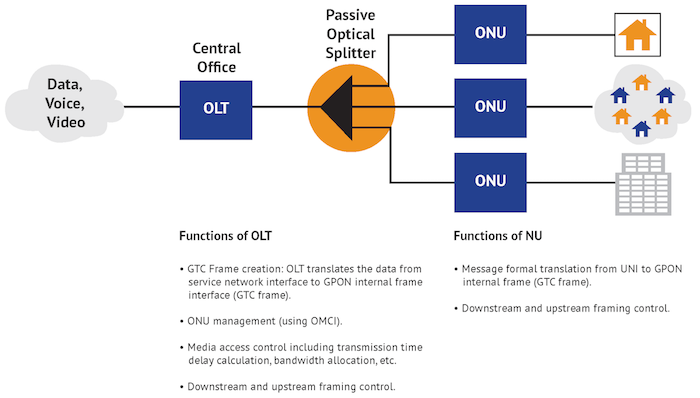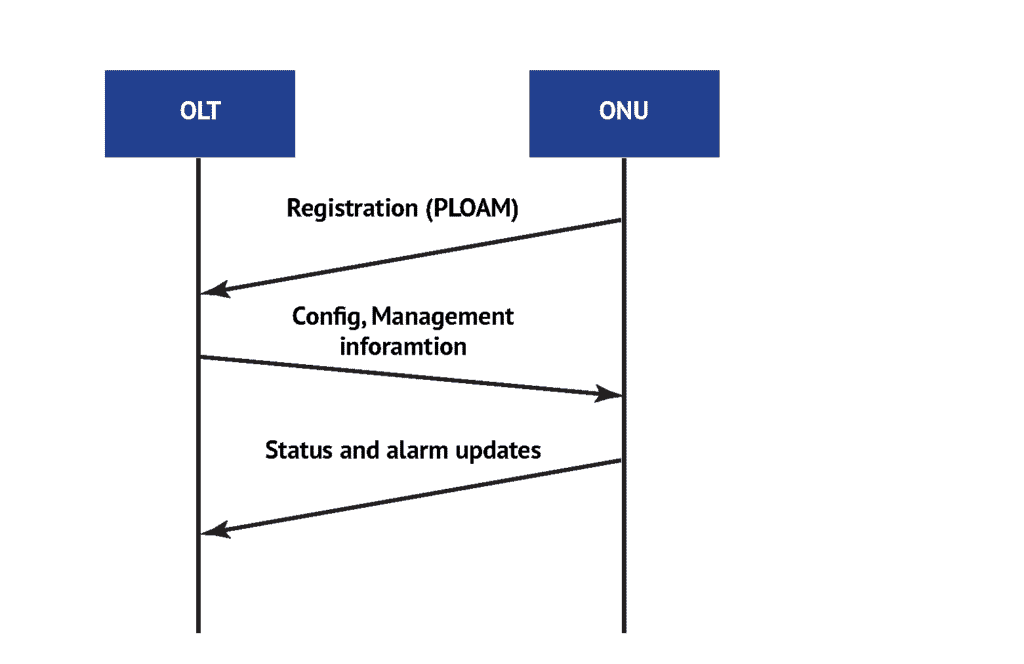In response to the surge in demand for high bandwidth from enterprises as well as residential customers, GPON (Gigabit Passive Optical Network) has emerged as the most economical fiber option. GPON is a form of fiber optic access network that uses a single optical fiber and an unpowered (passive) optical splitter to serve point-to-multipoint fiber to the premises (enterprise and residential). GPON supports triple play: voice, video, and data services. As shown in the figure below, a GPON system consists of: an OLT (Optical Line Terminal) at the central office, an ONU/ONT (Optical Network Unit / Optical Network Terminal) at the customer premises, and an ODN (Optical Distribution Network) in between the OLT and ONU.

What is OMCI?
OMCI (ONU Management Control Interface) defines a mechanism and message format that is used by the OLT to configure, manage, and monitor ONUs. The OMCI protocol messages are carried over Onu Management and Control Channel (OMCC) and are encapsulated into the GEM (GPON Encapsulation Method) frames. The traffic in the OMCC channel has the highest transmission priority. A protocol-independent MIB (Management Information Block) is used for configuring the entity information and storing the management records. OMCI is used by the OLT to manage the ONUs in the following areas:
- Configuration
- Fault management
- Performance management
- Security management
The OMCI also allows OLT to:
- Establish and release connections across ONUs
- Manage UNIs (User Network Interface) at the ONUs
- Request Configuration of ONUs
- Request performance statistics
- Monitor the alarms and inform system failures
The OMCI allows ONU to:
- Update the OLT with fault alarms, performance threshold, and MIB value changes.
How to set up OMCC?
On successful boot-up and registration of the ONU with the OLT, the OLT sets a GEM Port-ID to the ONU, which will be used by the ONU to map OMCC traffic. The procedure below explains the OMCC establishment.

OMCC Establishment:
The ONU Initiates and completes the registration process with the OLT using PLOAM (Physical Layer OAM).
The OLT learns the capability of ONU to support OMCI by using the PLOAM messages and establishes the OMCC>
On successful OMCC establishment:
– The OLT uses the OMCC to invoke the control and the management operations of the ONU
– The ONU uses the OMCC to update its status and alarms information to the OLT.
OMCI message format
The OMCI primitive data unit is 48 bytes in length and it is encapsulated in a GEM frame (with GEM header of 5 bytes). The OMCI packet format is shown below:

OMCI functions
According to the specification, the OMCI is used to perform the following functions to manage the ONUs:
Configuration Management
Configuration management defines and supports the basic configurations such as system reboot, self-test, equipment control, interface and port configuration, and transmission profile management.
Fault Management
The ONUs detect and report equipment, software, and interface failures using alarms to the OLT. The OLT collects the alarm information in real time for monitoring and resolution purposes. In addition to the failure reporting, the OMCI also supports test, measurement, and in-service monitoring.
Performance Management
The ONUs create entities on request from the OLT, and monitor the data traffic and history of different services as listed below:
AAL1, AAL2, AAL5, VC and VP are monitored in ATM mode
Encapsulated traffic is monitored in GEM mode
Link layer, network layer, and application layer are monitored in Ethernet mode
Security management
OMCI supports a mechanism that allows mutual authentication of OLT and ONU and subsequent secure communication of encryption keys. These keys are used to enhance data security by invoking the downstream encryption and password protection. It is necessary to protect the downstream data with security as every message is broadcasted to all downstream ONUs.
OMCI standards
ITU-T OMCI (ITU-T G.988) and OpenOMCI are the two well-known OMCI standards available (Verizon also released a standard for OMCI intended to be used in Verizon networks).
OpenOMCI is based on the ITU-T G.988 standard and it is consistent with G.988 with respect to the mandatory ME (Managed Entity) attributes. OpenOMCI differs in the following areas:
OpenOMCI is applicable only for the ONUs.
Some of the mandatory ME attributes are set with default values (thus avoiding the need to update/utilize the attribute)
Some of the optional ME attributes are made mandatory
Open CORD (Central Office Re-architected as a Datacenter) OMCI
VOLTHA v1.2 OMCI does not support any OMCI state machines necessary for complete ONU support (MIB synchronization/download, software downloads, alarm syncs, etc.). Currently it only includes support for the creation and parsing of a subset of MEs and operations/actions listed in the AT&T OpenOMCI V3 and ITU G.988 documents. VOLTHA v1.2 utilizes Scapy, a Python-based library, to generate OMCI frames with hardcoded ME attributes to send them to the ONUs.
As per the roadmap, the OpenOMCI stack is expected to be released by vOLTHA v2.0 / vOLTHA v3.0.

